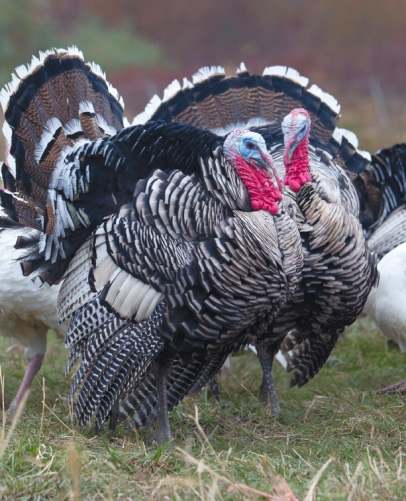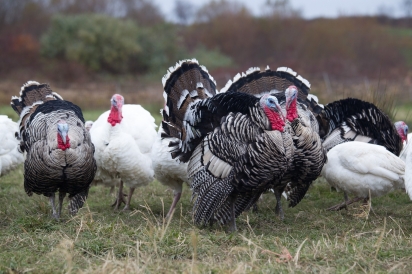Heritage Breed: Let's Talk (Narragansett) Turkey
With their stunning black and white plumage, their glorious black and bronze tail feathers in full display and their dramatic red necks, Narragansett turkeys look like the idealized images of Pilgrim-era Thanksgiving turkeys. A local species, they take their name from Narragansett Bay. And they taste absolutely delicious, according to turkey fanciers in Rhode Island and beyond.
So why are these birds an endangered breed?
Let’s go back to around 1550, when domesticated turkeys, native to Mexico, were brought to the Old World by British sailors. They were enthusiastically consumed by British and European diners, including Queen Marguerite of Navarre and, a couple of centuries later, the noted French gastronome Jean Anthelme Brillat-Savarin.
These same birds were brought to colonial New England with British and European settlers in the 17th century. As a result of cross-breeding with native Eastern wild turkeys, a new breed of so-called “heritage” turkeys emerged. These breeds—including the Narragansett, Royal Palm, Slate, Standard Bronze, Bourbon Red, Buff, Black and Midget White—retained many of the characteristics of their wild brethren. They were lean and muscular with a large appetite for foraged bugs and grass, able to fly away from predators and reproduce naturally. (Modern turkeys can’t fly and can’t reproduce the old-fashioned way. Rather they require artificial insemination.)
Until the 1920s, these turkeys were staples of small family farms, and they became the foundation of the New England turkey industry. However, as small-scale agriculture evolved into a larger, more industrialized system, agribusiness recognized the need for a more cost-efficient turkey. Enter the Broad Breasted White Turkey in the 1940s—a large, heavy, short-legged breed that, according to one farmer, is raised to “grow and get fat.”
“Mainstream agriculture requires high-producing breeds that deliver a lot of protein and are cheap to feed,” said Alison Martin, program director at the Livestock Conservancy, a Pittsboro, North Carolina–based nonprofit organization that works to conserve endangered breeds of livestock and poultry. The modern broad-breasted turkey is raised on grain in cramped confinement— a condition that can create health problems without preventive treatment with antibiotics—and, at an average weight of 28.2 pounds, is ready for market in four to six months. Compare that with the typical 10- to 21-pound heritage turkey, which likes to run free, eat voraciously and requires a minimum of six months to reach butcher weight. As such, heritage turkeys were all but replaced by the modern white “supermarket turkey.”
The good news, though, is the resurgence of heritage turkeys. A 1997 study reported there were fewer than a half dozen Narragansett breeders; in 2006 the Conservancy identified 10,404 breeding birds and 42 primary breeding flocks (with flocks defined as having 50 or more breeders).
Additionally, Slow Food USA has placed the heritage turkeys in its “Ark of Taste,” a catalog of over 200 foods in danger of extinction. “We’re bringing them back from the brink,” said Martin.
Why the interest? “We’re seeing more consumers who want to eat locally and get to know their farmers, and younger people who want to farm,” said Martin. Larger markets are being created through farmers’ markets, CSAs and mail-order outlets, while social media is spreading the word among potential consumers.
Rick Hermonot, owner of Ekonk Hill Turkey Farm in Sterling, Connecticut (just over the state line from Coventry, Rhode Island), is one such farmer. Originally dairy farmers, he and his wife, Elena, switched to raising free-range heritage turkeys (including Narragansetts), white turkeys, chickens, sheep and goats some 15 years ago, because of the prohibitive cost of maintaining a dairy operation. To make ends meet, they also run a meat and poultry CSA and a yearround farm store.
“People like the idea of an old-fashioned bird, the way they like heirloom tomatoes,” Hermonot said. “Even though they’re not the prettiest bird, because of their narrower breasts, they are very traditional on a Thanksgiving table.” The birds are very “flavorful and a little more gamey” than white turkeys, and less tough than wild turkeys, he added. Most of their meat is dark.
At upwards of $7 per pound, heritage birds are not cheap. That’s because they are poor feed converters. In other words, they require a lot of food to put on weight.
“They’re hard to catch, a pain to raise, and the babies are becoming more expensive,” Hermonot added. Predators such as fisher cats, coyotes, bobcats, bears, owls and hawks, which inhabit the 27,000-acre Pachaug State Forest that abuts the farm, are a serious challenge. After losing a number of birds, he and his wife purchased an Anatolian Shepherd named Blue, a good-natured dog who lives in the pasture with the turkeys.
“We now have a Turkish dog guarding turkeys,” he laughs.
Sherrie Battles, of Stone Pony Farm in Westport, Massachusetts, is equally enthusiastic about her flock of around 30 organic heritage turkeys. She calls her Narragansetts, Chocolates, Royal Palms and Bourbon Reds “spectacular.”
“The whole key is to actually raise and consume these turkeys—it will help keep the breed and gene pool alive. More people who have health and diet issues want to avoid putting unhealthy factory-raised food as the centerpiece of their table,” she said. Again, her birds are costly: about $100 for a 15- to 16-pound bird.
Karla Simmons of Simmons Farm in Middletown, Rhode Island, started raising about 30 to 50 heritage turkeys five years ago, in response to customer demand. She praises their “deep flavor and less mushiness” compared to supermarket turkeys. As with the above-mentioned farmers, because of limited quantities, it’s important to order a heritage bird by September (or earlier) for Thanksgiving.
As for preparing the birds, every cook has his or her own method. Some say that roasting heritage turkeys for a short time at a high temperature works best. More commonly, you’ll hear the advice “low and slow.” Alison Martin rubs her turkey with butter, seasons it with salt and pepper and cooks it unstuffed for 12 to 15 minutes per pound at 325°. When a meat thermometer inserted in the thigh reads 160°, the bird is done. Other cooks rub the birds with olive oil and slip garlic and fresh herbs under the skin before roasting. Karla Simmons soaks her heritage turkeys in an apple cider brine before roasting them. “The flavor is amazing,” she said.
So let’s raise a glass to the Narragansett and other heritage turkeys. A lost breed found again, a delicious bird on the table, and a truly local product, they are a wonderful way to give thanks on Thanksgiving Day.






